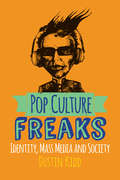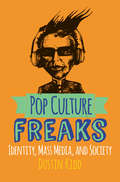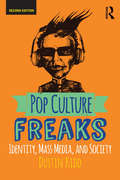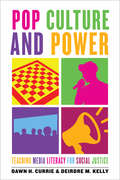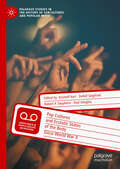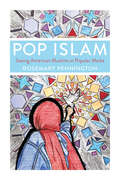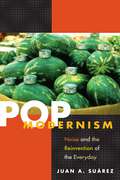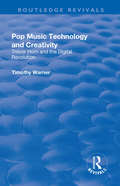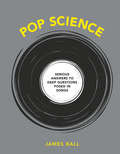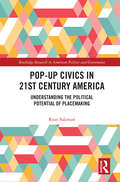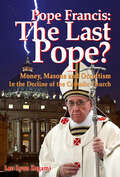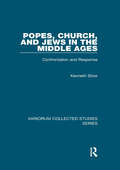- Table View
- List View
Pop Culture Freaks
by Dustin KiddLove it or hate it, popular culture permeates every aspect of contemporary society. In this accessibly written introduction to the sociology of popular culture, Dustin Kidd provides the tools to think critically about the cultural soup served daily by film, television, music, print media, and the internet. Utilizing each chapter to present core topical and timely examples, Kidd highlights the tension between inclusion and individuality that lies beneath mass media and commercial culture, using this tension as a point of entry to an otherwise expansive topic. He systematically considers several dimensions of identity-race, class, gender, sexuality, disability-to provide a broad overview of the field that encompasses classical and contemporary theory, original data, topical and timely examples, and a strong pedagogical focus on methods. Pop Culture Freaks encourages students to develop further research questions and projects from the material. Both quantitative and qualitative analyses are brought to bear in Kidd's examination of the labor force for cultural production, the representations of identity in cultural objects, and the surprising differences in how various audiences consume and use mass culture in their everyday lives.
Pop Culture Freaks
by Dustin KiddLove it or hate it, popular culture permeates every aspect of contemporary society. In this accessibly written introduction to the sociology of popular culture, Dustin Kidd provides the tools to think critically about the cultural soup served daily by film, television, music, print media, and the internet. Utilizing each chapter to present core topical and timely examples, Kidd highlights the tension between inclusion and individuality that lies beneath mass media and commercial culture, using this tension as a point of entry to an otherwise expansive topic. He systematically considers several dimensions of identity--race, class, gender, sexuality, disability--to provide a broad overview of the field that encompasses classical and contemporary theory, original data, topical and timely examples, and a strong pedagogical focus on methods. Pop Culture Freaks encourages students to develop further research questions and projects from the material. Both quantitative and qualitative analyses are brought to bear in Kidd’s examination of the labor force for cultural production, the representations of identity in cultural objects, and the surprising differences in how various audiences consume and use mass culture in their everyday lives.
Pop Culture Freaks: Identity, Mass Media, and Society
by Dustin KiddLove it or hate it, popular culture permeates every aspect of contemporary society. In this accessibly written introduction to the sociology of popular culture, Dustin Kidd provides the tools to think critically about the cultural soup served daily by film, television, music, print media, and the internet.Utilizing each chapter to present core topical and timely examples, Kidd highlights the tension between inclusion and individuality that lies beneath mass media and commercial culture, using this tension as a point of entry to an otherwise expansive topic. He systematically considers several dimensions of identity,race, class, gender, sexuality, disability,to provide a broad overview of the field that encompasses classical and contemporary theory, original data, topical and timely examples, and a strong pedagogical focus on methods. Pop Culture Freaks encourages students to develop further research questions and projects from the material. Both quantitative and qualitative analyses are brought to bear in Kidd's examination of the labour force for cultural production, the representations of identity in cultural objects, and the surprising differences in how various audiences consume and use mass culture in their everyday lives.
Pop Culture Freaks: Identity, Mass Media, and Society
by Dustin KiddUtilizing each chapter to present core topical and timely examples, Pop Culture Freaks highlights the tension between inclusion and individuality that lies beneath mass media and commercial culture, using this tension as a point of entry to an otherwise expansive topic. He systematically considers several dimensions of identity—race, class, gender, sexuality, disability—to provide a broad overview of the field that encompasses classical and contemporary theory, original data, topical and timely examples, and a strong pedagogical focus on methods. Pop Culture Freaks encourages students to develop further research questions and projects from the material. Both quantitative and qualitative analyses are brought to bear in Kidd's examination of the labor force for cultural production, the representations of identity in cultural objects, and the surprising differences in how various audiences consume and use mass culture in their everyday lives. This new, revised edition includes update examples and date to reflect a constantly changing pop culture landscape.
Pop Culture and Power: Teaching Media Literacy for Social Justice
by Dawn H. Currie Deirdre M. KellyLiteracy education has historically characterized mass media as manipulative towards young people who, as a result, are in need of close-reading "skills." By contrast, Pop Culture and Power treats literacy as a dynamic practice, shaped by its social and cultural context. It develops a framework to analysze power in its various manifestations, arguing that power works through popular culture, not as everyday media. Pop Culture and Power thus explores media engagement as an opportunity to promote social change. Seeing Deeming pop culture as a teaching n opportunity rather than as a threat, Dawn H. Currie and Deirdre M. Kelly worked with K-12 educators to investigate how pop culture can support teaching for social justice. Currie and Kelly began the research for this project with a teacher education seminar in media analysis where participants designed classroom activities using board games, popular film, music videos, and advertisements. These activities were later piloted in participants’ classrooms, enabling the authors to identify and address practical issues encountered by student learners. Case studies describe the design, implementation, and retrospective assessment of activities engaging learners in media analysis and production. Following the case studies, the authors consider how their approach can foster ethical practices when engaging in the digital environment. Pop Culture and Power offers theoretically -informed yet practical tools that can help educators prepare youth for engagement in our increasingly complex world of mediated meaning making.
Pop Culture: The Culture of Everyday Life
by Shirley FedorakWhile usually associated with facets of commercial culture, pop culture can and must be analyzed as an important part of material, economic, and political culture. The author begins by defining popular culture, outlining criticisms, and examining the impact of globalization on pop culture. She then explores mass media and popular culture (soap operas, Egyptian melodramas, Afro-Cuban rap music, and virtual communities), artistic expression and popular culture (graffiti art and body art), and gatherings and popular culture (fast food in Japan, equality in sport, and wedding rituals).
Pop Cultures and Ecstatic States of the Body Since World War II (Palgrave Studies in the History of Subcultures and Popular Music)
by Detlef Siegfried Kristoff Kerl Robert P. Stephens Olaf StieglitzThis book examines the many, varied historical entanglements between pop cultures and ecstatic, euphoric, and intoxicated bodies, focusing on the period between the 1950s and the 1980s. Charting a new course by bringing together pop culture studies, the history of bodies, and the history of emotions, the volume unites new historical perspectives on different forms of corporeal pleasure and offers novel methods for studying the social and cultural politics of ecstasy.
Pop Finance: Investment Clubs and the New Investor Populism
by Brooke HarringtonDuring the 1990s, the United States underwent a dramatic transformation: investing in stocks, once the province of a privileged elite, became a mass activity involving more than half of Americans. Pop Finance follows the trajectory of this new market populism via the rise of investment clubs, through which millions of people across the socioeconomic spectrum became investors for the first time. As sociologist Brooke Harrington shows, these new investors pour billions of dollars annually into the U.S. stock market and hold significant positions in some of the nation's largest firms. Drawing upon Harrington's long-term observation of investment clubs, along with in-depth interviews and extensive survey data, Pop Finance is the first book to examine the origins and impact of this mass engagement in investing. One of Harrington's most intriguing findings is that gender-based differences in investing can create a "diversity premium"--groups of men and women together are more profitable than single-sex groups. In examining the sources of this effect, she delves into the interpersonal dynamics that distinguish effective decision-making groups from their dysfunctional counterparts. In addition, Harrington shows that most Americans approach investing not only to make a profit but also to make a statement. In effect, portfolios have become like consumer products, serving both utilitarian and social ends. This ties into the growth of socially responsible investing and shareholder activism--matters relevant not only to social scientists but also to corporate leaders, policymakers, and the millions of Americans planning for retirement.
Pop Goes Korea: Behind the Revolution in Movies, Music, and Internet Culture
by Mark James RussellFrom kim chee to kim chic! South Korea came from nowhere in the 1990s to become one of the biggest producers of pop content (movies, music, comic books, TV dramas, online gaming) in Asia--and the West.<P><P> Why? Who's behind it? Mark James Russell tells an exciting tale of rapid growth and wild success marked by an uncanny knack for moving just one step ahead of changing technologies (such as music downloads and Internet comics) that have created new consumer markets around the world. Among the media pioneers profiled in this book is film director Kang Je-gyu, maker of Korea's first blockbuster film Shiri; Lee Su-man, who went from folk singer to computer programmer to creator of Korea's biggest music label; and Nelson Shin, who rose from North Korea to the top of the animation business. Full of fresh analysis, engaging reportage, and insightful insider anecdotes, Pop Goes Korea explores the hallyu (the Korean Wave) hitting the world's shores in the new century.Mark James Russell has been living in Korea since 1996. His articles about Korean and Asian cultures have appeared in Newsweek, The New York Times, International Herald-Tribune, and many other publications. He is currently the Korea/Japan Bureau Chief for Asian Movie Week magazine.
Pop Grenade: From Public Enemy to Pussy Riot - Dispatches from Musical Frontlines
by Matthew CollinAn adrenalin-charged trip through some of the cultural flashpoints of the past few decades, Pop Grenade celebrates the power of music as a force for change. Based on first-hand, personal reportage from raves, riots and rebellions, it explores how music has been used as a weapon in struggles for liberation and attempts to create temporary paradises. From Berlin&’s anarchic techno scene after the fall of the Wall to outlaw sound systems in wartime Bosnia, from Moscow during the crackdown on Pussy Riot to New York in the militant early years of hip-hop, it tells the extraordinary stories of some of the world&’s most audacious musical freedom fighters, disco visionaries and rock&’n&’roll rebels with a cause.
Pop Icons and Business Legends: History of Commerce and Heritage of Culture
by Hank MooreA unique and fresh perspective on how to achieve business success based on the careers of modern history&’s greatest pop figures. Stroll through the past and discover the fusion of pop culture and business. From Walt Disney to Bill Gates, from Burt Bacharach to Howard Hughes, from Steven Spielberg to John D. Rockefeller, and from Col. Harland Sanders to Steve Jobs, this is the comprehensive study of pop icons, historical innovations, and business pioneers. In Pop Icons and Business Legends, legendary business advisor and former presidential speech writer Hank Moore embraces the past as a roadmap to the future. This is history, cultural enlightenment, and business innovation, all rolled in one, plus a dynamic panorama of non-profit and humanitarian contributions to society. &“How can one person with so much insight into cultural history and nostalgia be such a visionary of business and organizations? Hank Moore is one of the few who understands the connection.&” —Dick Clark, TV icon &“Hank Moore's Business Tree™ is the most original business model of the last 50 years.&” —Peter Drucker, business visionary
Pop Islam: Seeing American Muslims in Popular Media
by Rosemary PenningtonIn the West, Islam and Muslim life have been imagined as existing in an opposing state to popular culture—a frozen faith unable to engage with the dynamic way popular culture shifts over time, its followers reduced to tropes of terrorism and enemies of the state. Pop Islam: Seeing American Muslims in Popular Media traces narratives found in contemporary American comic books, scripted and reality television, fashion magazines, comedy routines, and movies to understand how they reveal nuanced Muslim identities to American audiences, even as their accessibility obscures their diversity. Rosemary Pennington argues that even as American Muslims have become more visible in popular media and created space for themselves in everything from magazines to prime-time television to social media, this move toward "being seen" can reinforce fixed ideas of what it means to be Muslim. Pennington reveals how portrayals of Muslims in American popular media fall into a "trap of visibility," where moving beyond negative tropes can cause creators and audiences to unintentionally amplify those same stereotypes. To truly understand where American narratives of who Muslims are come from, we must engage with popular media while also considering who is allowed to be seen there—and why.
Pop Modernism: Noise and the Reinvention of the Everyday
by Juan A. SuárezPop Modernism examines the popular roots of modernism in the United States. Drawing on a wide range of materials, including experimental movies, pop songs, photographs, and well-known poems and paintings, Juan A. Suárez reveals that experimental art in the early twentieth century was centrally concerned with the reinvention of everyday life. Suárez demonstrates how modernist writers and artists reworked pop images and sounds, old-fashioned and factory-made objects, city spaces, and the languages and styles of queer and ethnic “others.” Along the way, he reinterprets many of modernism’s major figures and argues for the centrality of relatively marginal ones, such as Vachel Lindsay, Charles Henri Ford, Helen Levitt, and James Agee. As Suárez shows, what’s at stake is not just an antiquarian impulse to rescue forgotten past moments and works, but a desire to establish an archaeology of our present art, culture, and activism.
Pop Music Production: Manufactured Pop and BoyBands of the 1990s (ISSN)
by Phil HardingPop Music Production delves into academic depths around the culture, the business, the songwriting, and most importantly, the pop music production process. Phil Harding balances autobiographical discussion of events and relationships with academic analysis to offer poignant points on the value of pure popular music, particularly in relation to BoyBands and how creative pop production and songwriting teams function.Included here are practical resources, such as recording studio equipment lists, producer business deal examples and a 12-step mixing technique, where Harding expands upon previously released material to explain how ‘Stay Another Day’ by East 17 changed his approach to mixing forever. However, it is important to note that Harding almost downplays his involvement in his career. At no point is he center stage; he humbly discusses his position within the greater scheme of events. Pop Music Production offers cutting-edge analysis of a genre rarely afforded academic attention.This book is aimed at lecturers and students in the subject fields of Music Production, Audio Engineering, Music Technology, Popular Songwriting Studies and Popular Music Culture. It is suitable for all levels of study from FE students through to PhD researchers. Pop Music Production is also designed as a follow-up to Harding’s first book PWL from the Factory Floor (2010, Cherry Red Books), a memoir of his time working with 1980s pop production and songwriting powerhouse, Stock Aitken Waterman, at PWL Studios.
Pop Music: Technology and Creativity - Trevor Horn and the Digital Revolution (Ashgate Popular And Folk Music Ser.)
by Timothy WarnerThis title was first published in 2003.This highly original and accessible book draws on the author’s personal experience as a musician, producer and teacher of popular music to discuss the ways in which audio technology and musical creativity in pop music are inextricably bound together. This relationship, the book argues, is exemplified by the work of Trevor Horn, who is widely acknowledged as the most important, innovative and successful British pop record producer of the early 1980s. In the first part of the book, Timothy Warner presents a definition of pop as distinct from rock music, and goes on to consider the ways technological developments, such as the transition from analogue to digital, transform working practices and, as a result, impact on the creative process of producing pop.
Pop Out: Queer Warhol
by Jennifer Doyle José Esteban Muñoz Jonathan FlatleyAndy Warhol was queer in more ways than one. A fabulous queen, a fan of prurience and pornography, a great admirer of the male body, he was well known as such to the gay audiences who enjoyed his films, the police who censored them, the gallery owners who refused to show his male nudes, and the artists who shied from his swishiness, not to mention all the characters who populated the Factory. Yet even though Warhol became the star of postmodernism, avant-garde, and pop culture, this collection of essays is the first to explore, analyze, appreciate, and celebrate the role of Warhol's queerness in the making and reception of his film and art. Ranging widely in approach and discipline, Pop Out demonstrates that to ignore Warhol's queerness is to miss what is most valuable, interesting, sexy, and political about his life and work.Written from the perspectives of art history, critical race theory, psychoanalysis, feminist theory, cinema studies, and social and literary theory, these essays consider Warhol in various contexts and within the history of the communities in which he figured. The homoerotic subjects, gay audiences, and queer contexts that fuel a certain fascination with Warhol are discussed, as well as Batman, Basquiat, and Valerie Solanas. Taken together, the essays in this collection depict Warhol's career as a practical social reflection on a wide range of institutions and discourses, including those, from the art world to mass culture, that have almost succeeded in sanitizing his work and his image.Contributors. Jennifer Doyle, Jonathan Flatley, Marcie Frank, David E. James, Mandy Merck, Michael Moon, José Esteban Muñoz, Eve Kosofsky Sedgwick, Brian Selsky, Sasha Torres, Simon Watney, Thomas Waugh
Pop Science: Serious Answers to Deep Questions Posed in Songs
by James BallA Pulitzer Prize–winning journalist uses data, facts, and science to deliver hilarious, fascinating answers to some of the most famous questions in pop music history. “Is there life on Mars? Where have all the flowers gone? Pop songs can pose excellent questions and James Ball has given them the answers they deserve.”—The Times (UK) Some of the most famous questions of our time have come to us in pop songs. “What is love?” “How soon is now?” “How do you solve a problem like Maria?” But do you know the answers? Breaking down lyrics from Bob Dylan, Queen, Rihanna, the Ting Tings, Billy Joel, and a variety of other genre- and decade-spanning artists with colorful graphs and Venn diagrams,Pop Science reveals the exact points where lowbrow pop culture and the highest science and philosophy meet. By revealing the economic status of doggies in windows, what war is good for, and what becomes of the brokenhearted, James Ball uncovers what we have always known—that pop music is the key to life itself.
Pop with Gods, Shakespeare, and AI: Popular Film, (Musical) Theatre, and TV Drama
by Iris H. TuanApplying the theories of Popular Culture, Visual Culture, Performance Studies, (Post)Feminism, and Film Studies, this interdisciplinary and well-crafted book leads you to the fascinating and intriguing world of popular film, (musical) theatre, and TV drama. It explores the classical and contemporary cases of the literature works, both Eastern and Western, adapted, represented and transformed into the interesting artistic medium in films, performances, TV dramas, musicals, and AI robot theatre/films. ‘Iris Tuan’s book is wide ranging in scope and diversity, examining theatre, music, film and television productions from both Western and Asian countries. Tuan also surveys an extensive range of critical and theoretical perspectives, especially from performance studies and popular cultural studies, to offer context for her descriptions of the many different works. Some of her examples are well-known (Shakespeare’s Romeo & Juliet, Disney’s The Lion King) while others little known outside their place of origin (such as the Hakka Theatre of Taiwan) -- all are approached by the author with enthusiasm.’ —Susan Bennett, Professor of English, University of Calgary, Canada ‘Tuan takes us through multiple examples of contemporary popular performance in theatre/film/TV ranging from "high" art sources (Shakespeare or Journey to the West in films, Hirata's robotic theatre experiments) to "low" (Taiwanese TV soap operas Hakka Theatre: Roseki and Story of Yangxi Palace, Korean film Along with the Gods: The Two Worlds). The reader moves at a speed-dating pace through contemporary culture production and interpretive theories, encountering significant works, controversies (i. e., yellow face), and conundrums selected from China, Korea, Japan and the U. S. and filtered through a Taiwanese female gaze.’ —Kathy Foley, Professor of Theatre Arts, University of California Santa Cruz, USA
Pop-Up Civics in 21st Century America: Understanding the Political Potential of Placemaking (Routledge Research in American Politics and Governance)
by Ryan SalzmanHow people associate and engage in politics in the 21st century is notably different from similar behaviors in the 20th century. Ryan Salzman examines the political potential of placemaking, an increasingly popular set of behaviors that were unfamiliar to the American public until the last two decades. Placemaking exemplifies a shift that is occurring in the way Americans participate in their political system, and it appears that that participation is increasingly effective in the context of American democracy. Informed by interviews, surveys, and material review, Salzman compares the process of placemaking to traditional political and associational behaviors, providing evidence that placemaking has tremendous political potential. Placemaking is an innovative set of behaviors, largely understood to influence economic and community development. From painting crosswalks to community gardens, Americans are engaging in their communities with real political and civic consequences. This text expands our understanding of placemaking, updating the way we think about civic and political engagement in the 21st century. Pop-Up Civics in 21st Century America: Understanding the Political Potential of Placemaking will be of interest to those who study and research political behavior, civil society, arts and politics, social movements, and urban public policy.
Pop: How Graphic Design Shapes Popular Culture
by Steven Heller"Pop culture is often maligned as fleeting, but history shows that sometimes what is pop in one culture has time-honored resonance in later ones. This book is an attempt to show that pop culture, especially as seen through the lenses of design, illustration, satiric and political art (and other things), is integral to a broader understanding of who we are and where we are going. "-Steven Heller, from the Introduction. How do popular culture and graphic design influence one another? What are the goals of design? Are they to sell? To package? To entertain? The answers to these questions are complicated and are intimately tied to the effect design has on the overall culture. POP is the first book to analyze the role of graphic design in the broader culture, as well as the impact of design on other art and entertainment forms, from album covers to baseball stadiums. Author Steven Heller addresses such subjects as: --pop icons --viral and guerrilla advertising --political satire --the history of Interview, Monocle, Mad,and other magazines --illusionism and three-dimensional design --art for art's sake --design vs. decoration --the return of hand lettering --art for the masses. POP spans over 150 years during which popular culture has influenced mass perception and behavior.
Pope Francis: Journeys of a Peacemaker (Peacemakers)
by Mario I. AguilarThis volume is about Pope Francis, the diplomat. In his eight years of pontificate, Pope Francis as a peacemaker has propagated the ideas of human and divine cooperation to build a global human fraternity through his journeys outside the Vatican. This book discusses his endeavours to connect and develop a common peaceful international order between countries, faith communities, and even antagonistic communities through a peaceful journey of human beings. The book analyses his speeches, and meetings as a diplomat of peace, including his visits to Cuba and the United States, and his mediations for peace in Colombia, Myanmar, Kenya, Egypt, Turkey, Jordan, Jerusalem, the Central African Republic, Sri Lanka, and Bangladesh. It discusses the role of Pope Francis as mediator in different circumstances through his own writings, letters, and Vatican documents; his encounters with world leaders; as well as his contributions to a universal understanding on inter-faith dialogue, climate change and the environment, and human migration and the refugee crisis. The volume also sheds light on his ideas on a post-pandemic just social order, as summarised in his 2020 encyclical. A definitive work on the diplomacy and the travels of Pope Francis, this volume will be of great interest to scholars and researchers of religious studies, peace and conflict studies, ethics and philosophy, and political science and international relations. It will be of great interest to the general reader as well.
Pope Francis: Money, Masons and Occultism in the Decline of the Catholic Church
by Brad Olsen Leo ZagamiPope Francis: The Last Pope? reveals the possible reasons for the choice of historical abdication of Benedict XVI and traces the process that led to the election of Cardinal Bergoglio: the Pope who many have prophesized will be the last and will bring the Catholic Church to its end. The book details the history of this prophecy, which was hidden away in the Vatican for hundreds of years and predicts that the reign of the last Pope will herald the beginning of "great apostasy" followed by "great tribulation." It also explores the recent scandals in the Catholic Church and addresses questions including What pressures decreed the end of the pontificate of Benedict XVI? What powers have an interest for the Church to end? and What is the relationship between the Vatican and the New World Order? Perfect for anyone interested in prophecies about the end times, Pope Francis: The Last Pope reveals the truth about what numerology says about the last Pope and the darkness that may follow him, as well as fascinating investigations into the gay lobby, Freemasonry, and the Jesuit agenda in the Vatican and how it relates to the first Borgia Pope, the legend of the White Pope and the Black Pope, and how Benedict's resignation may fulfill an ancient prophecy.
Popes and Bankers: A Cultural History of Credit and Debt, from Aristotle to AIG
by Jack CashillAMIDST THE WRECKAGE OF FINANCIAL RUIN, PEOPLE ARE LEFT PUZZLING ABOUT HOW IT HAPPENED. WHERE DID ALL THE PROBLEMS BEGIN?For the answer, Jack Cashill, a journalist as shrewd as he is seasoned, looks past the headlines and deep into pages of history and comes back with the goods. From Plato to payday loans, from Aristotle to AIG, from Shakespeare to the Salomon Brothers, from the Medici to Bernie Madoff--in Popes and Bankers Jack Cashill unfurls a fascinating story of credit and debt, usury and "the sordid love of gain."With a dizzying cast of characters, including church officials, gutter loan sharks, and even the Knights Templar, Cashill traces the creative tension between "pious restraint" and "economic ambition" through the annals of human history and illuminates both the dark corners of our past and the dusty corners of our billfolds.
Popes, Church, and Jews in the Middle Ages: Confrontation and Response (Variorum Collected Studies #876)
by Kenneth StowThe theme uniting the essays reprinted here is the attitude of the medieval Church, and in particular the papacy, toward the Jewish population of Western Europe. Papal consistency, sometimes sorely tried, in observing the canons and the principles announced by St Paul - that Jews were to be a permanent, if disturbing, part of Christian life - helped balance the anxiety felt by members of the Church. Clerics especially feared what they called Jewish pollution. These themes are the focus of the studies in the first part of this volume. Those in the second part explore aspects of Jewish society and family life, as both were shaped by medieval realities.
Poplorica
by Martin J. Smith Patrick J KrigerPop culture meets pop reference in this irreverent tour of twenty unlikely events, innovations, and individuals that forever changed how we live today--the food we eat, the places we live, the love we make, the fads we follow, the clothes we wear, the products we buy, and much more. Veteran journalists Martin J. Smith and Patrick J. Kiger make the offbeat their beat, revealing the odd, surprising, and amusing origins of inexplicable cultural phenomena. From slam dunks to rock 'n' roll punks, permanent press to pantyhose, black velvet painting to point-click culture, high-tech diapers to low-brow entertainment-they cover sports, business, music, media, film, fashion, and science, and explain a lot about why life today is so weird:-If homeowners hate yardwork, why do most suburban homes have lawns?-In the best-fed country on earth, how did thin become "in"?-When did the "convenience" of convenience food become more important than the food?-Was the sexual revolution really sparked by the disastrous honeymoon of a science geek?-Why are today's multimillion-dollar design and marketing plans for cars based on the biggest failure in automotive history?-How did the invention of air conditioning radically rebalance political power and affect the paths of presidents?The untold, unexpected, sometimes unholy stories are here, providing instant inside knowledge and richly entertaining insights into how and why we live as we do.
